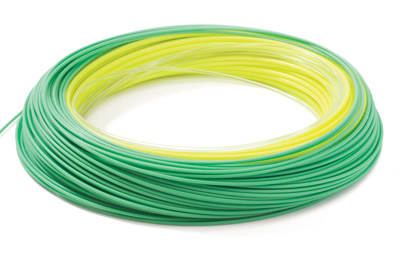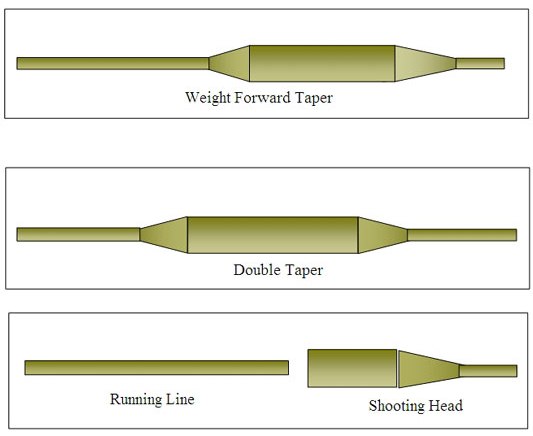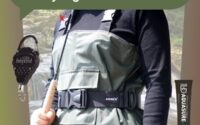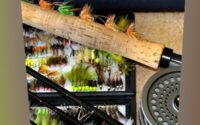| Disclosure: Just to be open and honest the buttons and links you click on in the website will in most cases take you to another website where you can purchase the products I am reviewing. As an Amazon Associate I earn from qualifying purchases. |
How to Choose a Fly Line – Some advice for beginners
There are many fly fishing lines on the market today made by many different manufacturers. If you do a search on Google you will come up with hundreds if not thousands of lines. For a beginner, this is an overload of information and can lead to an incorrect purchase. Here we will consider the options available and show you how to choose a fly line suited to your needs.
If you have not already purchased a single handed trout fly fishing rod then you would need to consider that first as the line needs to match the rod and reel setup. In that instance, you can purchase a ready made kit from a reputable dealer which can include all the items required to start out.
These are all made to match and balance the setup and are ideal for someone on a low budget. However, if you can afford a little more I would recommend buying the items individually as you can still get bargains but items with more strength and options than in a basic kit.

The first important aspect is to match your line rating to the rod you have or are considering. Each rod now has a line rating stamped on the butt section usually above the cork handle on the first few inches of the rod itself.
This figure is put there by the rod manufacturer and is a guide as to which line the rod has been made to make it a balanced setup.
Now we can move up or down a size and still fish very nicely but it will need a slight adjusting of the line head to make it work correctly and something for a more advanced caster. If you are beginning I would opt for the same line rating as marked on the rod.
Quick Post Navigation
A little more about fly line ratings
The rating for each fly line was worked out using the AFTM or Association of Fishing Tackle Manufacturers who designed a scale to measure the first ten yards or thirty feet of fly line which was to represent the average length of fly line a caster would be able to aerialise. The line was weighed in grains and each line rating is the same weight for floating sinking or intermediate lines. This then made it easier to match up lines and rods.
Whats the difference to double taper and weight forward fly lines?
To add to the confusion fly rod manufacturers have over the years produced many single handed fly rods with different line ratings. For instance a 6-7 or 7-8 covering two sizes or indeed a 6-8 covering three sizes and even 4-9 which really takes the biscuit. Now to a beginner, this will confuse you some what as in do you go for a 6 line or a 7 line for a rod that is rated 6-7.
The answer to this is you can use either the rod will cast both lines very well. However, for clarity these ratings were put there to allow anglers to match a rod with different types of fly line. In the 6-7 line rating, the 6 refers to a Double Taper (DT) line and the second number to a Weight Forward (WF) line.
A double taper is an older type of line and not so many manufacturers produce it now although some still do hence it being reflected on the butt line rating. A DT line is the same in both ends, for example, it tapers from the tip getting thicker to the middle then tapers down again to the other end, hence double tapered.

This line type is great for nice presentation of dry flies in a small river and good for roll casting as well as the normal overhead cast. Its great advantage is you can swap the line around after a few seasons if the forward taper is starting to show signs of wear and have a virtually new line to fish with again.
The weight forward fly line is designed to have the weight pushed closer to the front end of the line so the taper moves into the line then tapers down to a smooth running section of the line. As the weight is further forward the caster doesn’t need to have so much aerialised and can usually cast further with less effort. The weight forward line is not so good for delicate close casts but great for large stillwaters where distance becomes important. So to sum up a 6-7 will cast a 6 double taper (DT) and a 7 weight forward (WF) equally well.
Fly line density or sink rate!
Now we have the rating sorted next thing to consider is the fly line density. The density is the sink rate of the fly line. This can be anything from full floating to very fast sinking with loads of options in between. Why do we need different densities anyway? The answer to that is that every place you fish will have a different set of conditions.
These can be depth, flow rate, feeding fish depth or flat calm to name a few. These conditions can all be fished with a full floater but if the fish are lying deep in the pool what do you think your chances are of catching them? Pretty slim I would say as they are not going to want to chase your flies sitting on the top of the water when whatever has got them deep is right beside them.
However, as a beginner, I would recommend starting with a full floating line as it is easier to lift off the water surface to start another cast and hence easier to learn and it will cover a lot of situations. As you progress you could add an intermediate line and a medium sinker.
Fast sinking lines are only really for fast flowing deep water or really deep pools when you want to get your flies down quickly and something to aim for in the future as you gain casting experience.
In these situations, the addition of a poly leader to your fly line can add extra functionality to a floating or intermediate line as you add 5ft, 8ft or 12ft of heavier densities to get a floating line to perform as a sinking line. These are relatively cheap to purchase and can help out in a difficult situation. So again I would start with a full floater as a beginner.
What color should a fly line be?
The final piece to the puzzle is line color. Fly lines come in all colors and full floaters will usually be a highly visible color so you can see any movement or twitch of the line if a trout takes your fly. Especially handy when buzzer fishing just under the surface.
Intermediate lines will usually come in more neutral colors from greens and blues to completely clear, a nice addition when fishing for easily spooked trout. Sinking lines are usually darker in color and come usually in black, dark brown, blues and greens.
Some fly lines now come in two colors or two-toned. They switch usually between a bright head section and running line this shows the caster where the difference is in taper and with a bit of testing can find the sweet spot for making casts correctly. A very handy guide making life a lot easier. I used to mark my line with a black marker to show me, as casting the line out fast it’s not always easy to get the correct amount of line aerialised to perform it properly.
As manufacturers try out new technology they also come up with new color schemes and there are now camouflage lines on the market as well as pure white. Personally, I think the color is more to attract the angler than the fish as the clear butt and leader are what is important to present your flies correctly without spooking rather than fly line color.
Special fly lines and shooting heads!
Other options in fly line are now becoming more popular and special species target lines are on the market like tarpon, trout, river, lake, salmon, pike, and so on. If you have the funds and are species specific then these lines are a great addition to your arsenal.
Shooting heads are also increasing on the market and can be a great tool for distance casting. These are good when shore fishing against an onshore wind as the extra weight gives you the punch to get the cast out. Shooting heads are more intermediate to an advanced line and require more effort to cast properly as well as manage the running line which can become tangled very easily if not treated correctly. These are something to aim for when you get your casting skills improved.
Need more info on fly fishing check my review on fly fishing unleashed!
Now that you have decided on a fly line the next task is how to set up your fly line.




I’ve been fly fishing for a while (mostly high desert lakes and streams for trout). But now we live at the coast, and I have an opportunity for fish the surf of the Pacific ocean.
I’m going after red tail surf perch, and find that with my current setup I can’t really get the distance I need to get my fly in front of the fish…about 50 yards out.
Do you think the shooting head lines would be enough to get me there? And do they normally need to be paired with a special rod/reel?
Thanks as always for the great article!
Shooting heads are the only thing that are going to get you 50 yards casting. A cast of this distance was not possible without an 18 foot fly rod 10 years ago but now with shooting heads its quite possible with a 10 ft 8 weight.
You do need to match the line to the rod and reel in weight only and some rods are better suited (they need to be fast actioned) to get those extra yards out of the cast.
I’ve considered myself a natural fisherman pretty much out the womb, but I’d never been fly fishing. I stumbled upon this article and now I’m tempted to give it shot. I would totally agree that a Google search would provide an overwhelming amount of information about fly fishing line that beginners like me would scratch out heads over, so I’m glad a guide like this is available!
The internet is a great thing in many respects but unless the information is correct it can mislead newbies into all sorts of trouble when trying to set up their fly fishing gear. Choosing a fly line is one such area that needs correct info. As mentioned in the article you need to know what type of fishing you plan to do and match the line to the rod and reel weighting.
I am just a beginner and I like that floating line can perform as a sinking line. When I checked out the products I saw really good prices. But I wonder do you think that should I get the latest stuff or should I just get a full floating line? Which one should be better for a beginner?
I think you have misread the post a floating line will always be a floating line unless you add a sinking polyleader to make the tip sink a bit. This can get you out of a jam if you need to get down but nothing beats a proper sinking fly line. As a beginner as I mention in the post a floating line is best as it’s easier to mend and cast.
I will need to actually start fishing before even thinking about fly fishing. It was interesting to learn the intricacies of the type of lines used. theres obviously an art to this craft. Keener more than ever to get on the water and start fishing instead of offering vocal support with beer in hand.
Sam you don’t need to start fishing first you can start with fly fishing. It is FISHING just a different type, LOL!
My advice get a combo kit get some advice from a guide and practice some casting before you know it you will be catching trout or whatever fish you fancy.
I have been a fisherman all of my life, from streams and river’s to lake’s and the deep sea, however, I have never truly fly fished, surely I was somewhat mesmerized watching people do the art. Actually, I would love to step up into this art of effectively fly fishing, the tackle ratios seem simple enough through your content. What would your take be on a mid-range setup Mark? Thank you for the in-depth and very captivating post, and I hope to see you soon, for more on this great concept of fly fishing, sincerely, Jack
Hey Jack good to hear your thinking of taking the plunge. May I suggest you think about getting a combo setup. That way you get a combo setup ready to go fishing. All aspects of the combo are balanced to work with each other and it takes a lot of the guess work out of getting it all ready.
From weight and taper to line depth like sink rate I am so glad to have your site as a bookmarked resource. I will surely need it’s reference over and over again as I explore this new world of fishing. I am impressed with the detail you give in your explanations, most people I know talk with great passion about fly fishing but forget that it’s a second language to a non-fly fisherman or total novice.
Hey Andy I do try and make sense of the technical stuff to the beginner. As you say it is so easy to assume someone will get the meaning behind my dialogue but as this website is international not everyone will be reading it in their native language and making things simple will hopefully mean they get it too.
I have never been fly fishing for real, about 10 years ago, me and a friend took fly fishing class from the sporting goods store here in our town. It was fun, but of course I do not remember anything. I live in Colorado and I am constantly seeing people fishing in streams with fly lines and I always said that I would give it another shot.
The difference between the weight forward taper and double taper all seems a little confusing. Do you suggest that I go through another lesson on fly fishing or do you think I can wing it?
Another question I have is should I use the sinkable line or the floater line, for stream fishing?
Anyway if you could give me a couple of suggestions on which rod and reel to get, then I could get the line that goes with it. Great post and it really makes me want to fish in the spring here in Colorado.
Great to hear you are thinking about taking up fly fishing in the Spring Bobbi, its such a great pastime and one I thoroughly enjoy.
On your questions, a weight forward line os one where the taper of the line is pushed more to the front of the fly line and helps to load the fly rod quicker and will load the rod with less line out of the reel. This type of line is best suited for larger waterways like off a boat or on a lake where you need to get out a bit further.
It is also great for shore fishing into saltwater when there is usually an onshore wind making casting difficult. The extra loading of the rod help assist getting a cast to load the rod and flow out into the water.
The double taper fly line is the same from both ends so the heavy taper is in the middle of the line this means you need to get more line off the reel to make a cast in difficult conditions like the shore example above. The double taper was a favorite of trout fly men years ago before forward tapers were in existence.
The fact the line was the same from both ends meant they could reverse the line the next season and get another year out of a line that would now only last one season. The double taper fly line is good for smaller rivers and streams where delicate casting is important.
The usual cast would be an overhead short cast or a roll cast to the side, the simpler version of the spey cast on a single handed rod. Although it had its place the double taper line is rapidly being phased out and other delicate casting lines are being developed instead.
A sinking line or a floating one for a stream is a difficult one to answer without seeing the water. I say this as a fast deep stream will need a sinking line to get down quickly to deep fish while a slower flowing stream will be better with a floating line as the sinking one will most likely get you snagging the bottom.
So as a guide if its more than 6 ft deep and moving about 5-10 mph the sink it otherwise go for a floater. There is always the option of having a floater with a sinking polyleader added to the front when you do come up against a deep pool. I always carry a selection of densities of polyleader with me so if I need to get down I can.
Your final question on which rod and reel to get is also a difficult one. Although you did say you live in Colorado and see anglers fishing the stream I will accept this is what you are aiming for.
I would suggest a 9ft 5# weight rod and reel would be a good fit. A 10ft #6-7 would be more suited to stillwaters like lakes and shore fishing. If the streams are really small then I would even go down to a 8ft 4# weight.
As for makes and models that comes down to budget and personal expectation. There are loads of kits out there for someone who is looking to get in the sport and come with all you need to get started including the rod reel fly line already loaded with backing and leaders. Some also come with a selection of flies and sunglasses. A great way to get out there on a budget.
It’s the same thing when it comes to engineering. Your setup must match the other components of your equipment.
Same thing goes with the fly line. AFTM rating is a good origin point. You will know that it’s the real deal and chances of getting scammed is nearly zero if you choose your fly line by judging the AFTM rating.
I like the weight forward taper more but that’s a personal thing.
Exactly right Tyler, all the components need to match to keep the fly fishing outfit working properly. Using the AFTM rating for all aspects the rod ,reel and line will make sure you have a balanced outfit and be able to cast properly.
Weight forward fly lines are very much the norm now a days, you can get specialist lines like shooting heads, skagits, and heavy sinkers designed for a specific tack but a good weight forward will get you fishing in more places than others.
I only use a double taper fly line if I’m on a small river where a roll cast is needed usually because the backcast is covered in vegetation, a weight forward will not be great here.
There is certainly a lot more to fly fishing then simply casting your line and hoping for the best. I never realised that all these different ratios came into play. The weight and strength of the line, the colour,type of float and bait etc.I will certainly have to update my knowledge more so i will be following your site more often.
Andrew there are so many profiles, densities and colors of fly line available now it’s like finding a needle in the haystack for beginners. However do you know they are there mainly to catch the angler not the fish.
A plain old weight forward floating line will do wonders until you know a bit more about where and how you want to fly fish. Its then you can do a bit more research and pick something a bit more specialised.
Tight Lines!
I have always thought about getting into fly fishing, but never took the plunge because I thought it was confusing. Well, you cleared up one of the aspects for me.
I do have a question though. I also need a rod. What is the best one you would recommend for a beginner? Thank you in advance and I hope you have a great day!
With all aspects of fly fishing it depends on where and how you intend to fly fish. As a beginner I would suggest you buy a beginner fly fishing kit.
There are some great ones out there with line already spooled onto the reel and ready to fish. Takes a lot of the setting up out of it for you and then when you have tried it for a while and decided on which type of fly fishing you like the best you can buy other rods specific to the task.
A good beginner kit will only cost around $80-$150 and are as good as many of the better branded rods, reals and fly lines out there.
Designed specially by many of the top tackle houses out there to get newbies into the sport at a fraction of the cost knowing that once hooked they will come back to buy more tackle.
I’ve always associated fly fishing with fresh water. I fish saltwater so I never entertained the thought of getting a fly rod….until recently. I’ve seen some pics of people catching stripers off the beach with fly rods. Looks like a lot of fun. What rod, reel and line would you recommend?
For saltwater fly fishing you will want a set up a little heavier than freshwater fishing as the wing off shore is usually stronger. Saying that it really depends on how you plan to do it. On a kayak, standing in the flats, on a boat etc. each has its own merits and each will need a rod to match.
However a 10ft 8-9 weight rod would be my recommendation with a line to fit the weight. That should help with casting in wind. Saltwater lines are abundant on the market now too and don’t get affected by the salt or coldness of the sea so also worth checking out. All the big names do them, Airflo, Cortland, Rio etc.
I intend fishing small streams with fast water I’m aiming to but and 8ft #4 line but a problem I have had in the past when I use a floating line my flys skim the surface for the first 2 foot or so which is a disaster, I have used cleaned the line and put sinking past on the leader but to no avail
Hey Thomas, sounds like you need to put a mend into the line just as it hits the water as it seems the water is dragging the leader too quickly. The general guide is to slow a drift mend upwards, to speed up mend downwards this is when fishing in the direction of flow of course. If fishing against the flow then put a wiggle in the line just before it hits the water that should take the speed out of the leader to start the drift nicely. It all takes practice of course to get it correct. We have a post here on the topic of mending fly line for speed control.
I never really thought much of it when I was younger, but it really is important to choose the correct line for what you want to do. When I was younger and my uncle took me fishing, I always thought there were a set few basic lines that everyone used; but wow I was so wrong.
Hey, there is more to it that a lot of folks don’t know about, choosing a fly line does require a bit of thought before you decide which one to go for.
As mentioned in the article, rod size, target species and location are all relevant on the process. If you do a bit of research you will end up with a better set up and a better fly fishing experience all round.
I never really understood the importance of line ratings when I fished as a kid. To me, it always made sense to just pick the fattest, strongest line, because I always expected huge fish and didn’t want them to get away!
Boy, was I wrong.
One thing I didn’t understand in the post was the advantage of the two-tone line. What exactly is the advantage there?
Hi Nathaniell yes bigger is not always better. A fine line is required to present your fly with precision and delicacy which is essential to catching spooky trout.
Your question on two tone lines is a good one. The colour change is to show the change from the line head to the line body or running section. This is a gauge to show the angler the optimum point of load for the fly line. Each rod, line and angler due to bio mechanics have an optimum point which loads the rod correctly to cast a good cast. This is the amount of line airalised out side the tip ring when performing the cast.
When performing the back cast this line pulls the rod backwards which flexes and loads the rod ready for the forward cast. This is how casting is performed in its simplest form. The colour break allows a visual marker to allow beginners to see and feel the change and to become better at casting quicker. This color change is usually at the bottom ring close to the casters hands.
Choosing the correct line for fly fishing or rod and reel is crucial for success…can’t agree more at first glance when looking for line or any tackle, is wow there sure is a lot of it and what does it all do…
It helps to read from someone with first hand experience on what to use and why….good job Mark…
Maybe I get a fly rod for Christmas…or a new rod and reel or both….I’ve been good…:)
Thanks Tim, yes there is a lot of tackle on the market now. Some of it very good, some OK and some bad. Now its working out what is good from the bad. If you stick to the top brand names you can be fairly sure you are getting a good quality piece of gear and that doesn’t mean it costs the earth.
However if you go searching for budget gear there is a good chance that it was made for a back street tackle dealer out in the far east with less than perfect results. This is usually the reason it is poor quality. Now don’t misunderstand me I’m not saying the manufacturers in the far east are shoddy but sometimes poor quality materials are used to produce cheap tackle that is then flogged off to the masses for a few dollars. In fact a good percentage of all tackle is now made in the far east although the top brands still seek out quality materials to produce quality products.
Talking to your local tackle dealer is always a good idea especially if he knows the places you are going to be fishing. That way you can check out the feel of a rod in your hand and then decide before you buy.
As you have been good I will put in a special request with Santa to see what he can come up with! 🙂